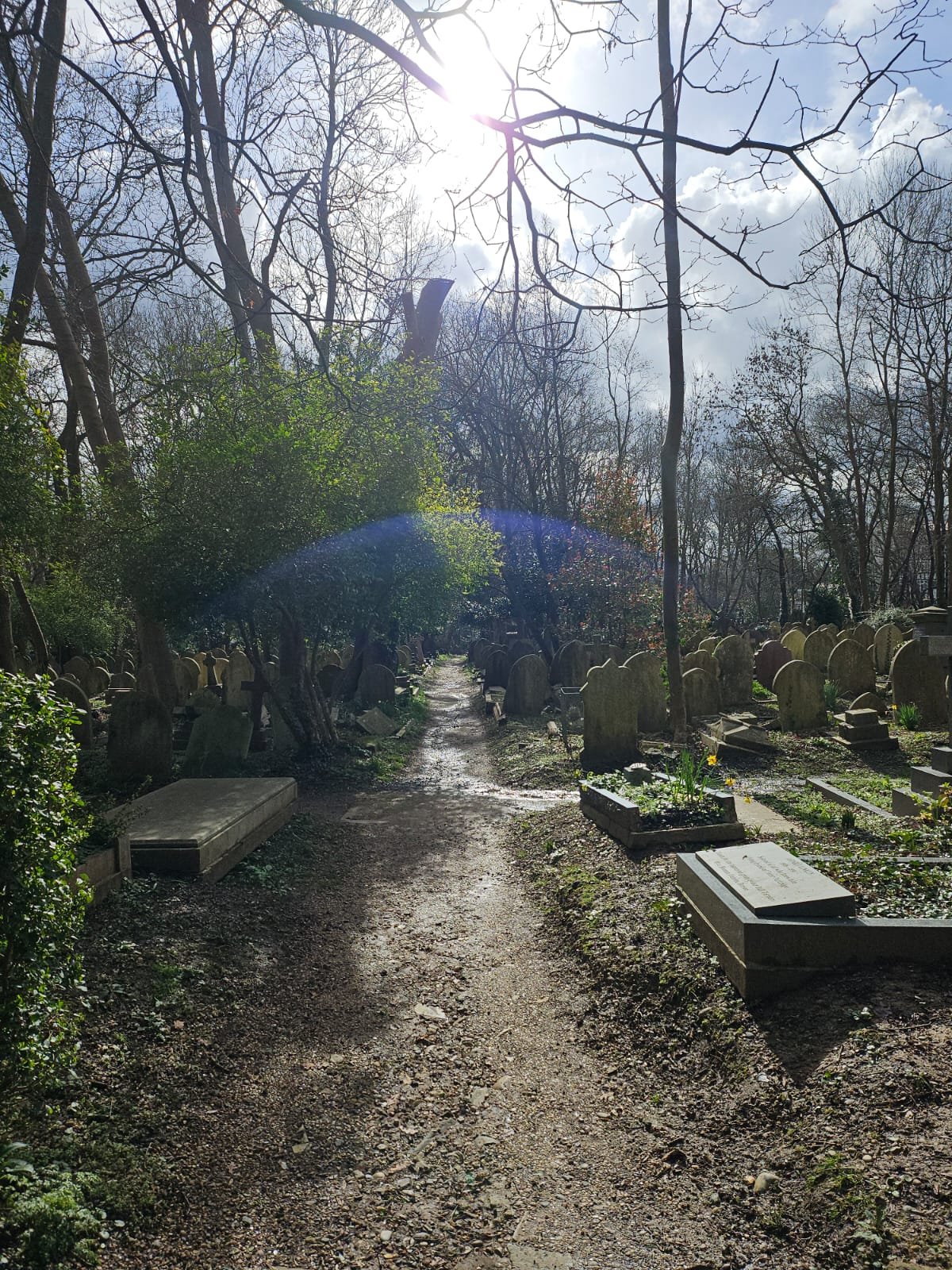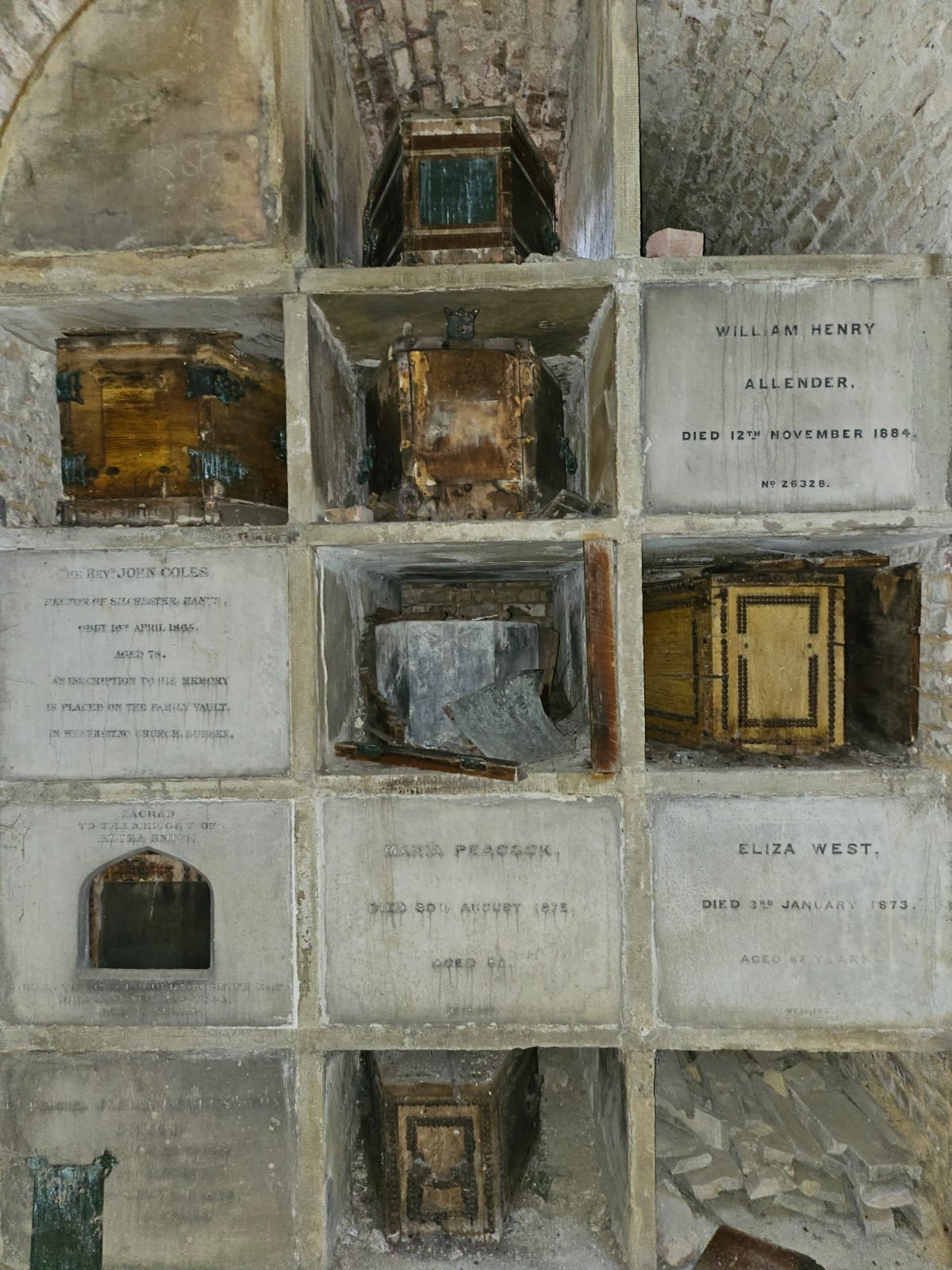Author: Molly Malone
Highgate Cemetery is a monument to the neo-Gothic vapourings and dramatics of Victorian Londoners. Designed as a ‘garden’ cemetery, it was built in the early part of the nineteenth century in an effort to prevent the over-population of the City of London by the dead. Nowadays it is a tourist destination as well as a functioning cemetery, and a celebration of managed decay and Victorian symbolism.
In 2024, if you wander around the City of London, you will inevitably come across countless tiny, well-kept and verdant gardens squeezed between offices, many of which are lined with gravestones that have been placed haphazardly against walls or, memorably, stacked around a tree in Old Saint Pancras. You don’t need to look too carefully: there are graves everywhere. Bunhill Fields off of Old Street is a wonderful larger example. Some are dotted with tombs worn smooth by centuries of exposure. These were the burial grounds of the Square Mile, which became an affront to both the sensibilities and the nostrils of Londoners. These supposed resting places were managed by unscrupulous clerics, who profited from each interment and piled bodies in pits twenty feet deep, before covering them with a mere dusting of earth. Bones, and worse, littered the ground. Grave robbing was a lucrative business, frowned upon by polite society but quietly encouraged by hospitals desperate for cadavers to train surgeons on.
The outcry against both this treatment of the dead, and the ‘miasma’ of decay that emanated from these burial grounds (which was considered toxic enough to be deadly) was a topic of heated discussion among those who were forced to bury their dead there, the newspapers and, eventually, the Houses of Parliament. Although it took several more decades for legislation to pass that would adequately address the sheer number of dead bodies resulting from the increasing population of London, work on the building of London’s Magnificent Seven cemeteries began in 1833.
Arguably the most famous of the Seven is Highgate, which opened in 1839 and is home to more than a few famous architectural wonders and notable inhabitants. In its heyday, Highgate was manned by enough security to warrant the cost of both burying a loved one there and the not terribly convenient necessity to travel to Highgate. The idea of garden cemeteries had been developed on the Continent, and Victorians were encouraged to stroll through a secure, beautifully maintained, and carefully curated space. Highgate could be seen from the centre of the City, and it was so different then to its current state of overgrown wildness. Sunday picnics were commonplace, although they are emphatically discouraged these days. Dozens of gardeners were employed, and the cemetery was run as a profitable business.
Walking around Highgate, you are struck by the symbolism associated with death. A grave was a Victorian Insta account, and clues adorn many of the monuments as to the achievements, and hubris, of those buried beneath. There are plenty that are common in all British and Christian cemeteries; a broken column indicating a young life cut short; a draped urn representing the veil between the living and the dead; three stones supporting a cross which are symbolic of the father, the son and holy ghost. The cross itself had been out of fashion for a few centuries but made a big comeback thanks to the Victorians. The grave of a world-famous champion bare-knuckle fighter features a carved dog, his faithful companion who was his chief mourner. Tom Sayers was a world-famous fighter and a working-class hero, and his funeral procession stretched from Highgate to Tottenham Court Road.
The tomb of George Wombwell is topped by a sleeping lion. In life, George was a celebrated zoo keeper, with his own private collection of exotic animals including, you’ve guessed it, a very tame lion called Nero.
The list of those laid to rest at Highgate is fascinating. Nearly two centuries of the notable, the rich and the inspirational are amongst the 170,000 who can be found there. George Michael, Bob Hoskins, Michael Faraday, Joseph Lister and Karl Marx are just a few. There is one relatively recent grave that particularly catches the eye, however, as you follow the main path into the West Side of the cemetery. That of Alexander Litvinenko, the Russian defector who was poisoned by Putin’s regime in 2006. The grave is strikingly modern. It features a photo of Litvinenko, itself an exceptionally unusual feature at Highgate. Most of the West Side of the cemetery is being slowly worn away by the weather and swallowed by mature trees and spring flowers. The graves are shades of grey and often barely legible. Litvinenko’s grave is pinkish-red and was, by necessity, dug deeper than most. His lead coffin is buried twelve feet below visitors’ feet as a precaution, after his murder through the use of polonium-210. This radioactive substance admittedly has a half-life of less than five months, so is unlikely to cause any further mischief.
Highgate is also home to a particularly rare type of cave spider, which is monitored by London Zoo and can be found in the overgrown tunnel enveloped by trees that is the Grade I listed Egyptian Avenue. The locked crypts lining each side of the Avenue are not full, and if you can prove lineage to those already interred there you are guaranteed a spot. However, the eye-watering cost of spending your afterlife in Highgate might be a consideration. It is currently estimated that a pretty basic full-body plot costs between £25,000 - £30,000. A place in an Egyptian Avenue tomb in 1839 cost the modern-day equivalent of up to £150,000.
Beyond the Avenue is the beautiful Circle of Lebanon, lined with tombs, including that of the activist and writer, Radclyffe Hall. Atop the Circle stood a famed cedar tree, from which the Circle took its name. The 200-year old tree was recently lost to a fungus and in its place now grows a baby cedar, but the loss of the original tree is felt keenly by those working and volunteering at Highgate.
The Terrace Catacombs, which visitors are only able to enter whilst on the official tour of the West cemetery, speaks eerily and eloquently of the turbulent history of Highgate, and the general stupidity of people. Originally, each entrance to the Catacombs had been guarded, which reassured both the families of the dead and the particularly practical. Doctors, being more aware than most in the nineteenth century of the prevalence of grave robbing, were keen to be safely ensconced in the locked and guarded Catacombs after meeting their maker. Coffins were lead-lined and placed on shelving. This practice left them exposed and vulnerable in the late 1960s. A sensationalist newspaper report of a ‘vampire’ roaming Highgate Cemetery led to the vandalism and destruction of much of the cemetery, including the desecration of the bodies laid to rest in the Catacombs. I will cover this more extensively in another blog, as it makes for very interesting reading. The damage took years to repair, coming as it did after several decades of cemetery-wide neglect after the Second World War. In fact, it was only addressed when The Friends of Highgate group was formed in 1975 to repair and protect the site.
For those of us who find beauty, comfort, and peace in a walk around a cemetery, there are few like Highgate. My interest in these places stems from my local cemetery in Chingford, London. Not considered one of the greats, it is notable perhaps only for its two most famous residents, the Kray twins. I clearly remember their funeral processions, one of which I watched from my junior school window, attended by an interesting if, by then, anonymous cohort of 60s gangsters, molls and actors, glamour faded after thirty years. Chingford Cemetery also features a pauper’s grave, a mound of earth with a few markers sticking out haphazardly. There are Commonwealth war graves and an overgrown area completely obscured by feral ivy and holly trees, where the stone markers are almost as buried as those they are intended to commemorate and completely illegible.
Cemeteries are havens for wildlife. From the ubiquitous grey squirrels of Chingford to the striking green parakeets that have spread from central London to inhabit most trees within the M25 over the last couple of decades, many of which have made Highgate their home. Perhaps it is simply the knowledge that cemeteries of this type are dying out if you’ll forgive the pun. As cremation becomes a more popular and cost-effective option, the marble tombs of our recent ancestors are icons of a lost age. Life and death are no longer celebrated in stone.










